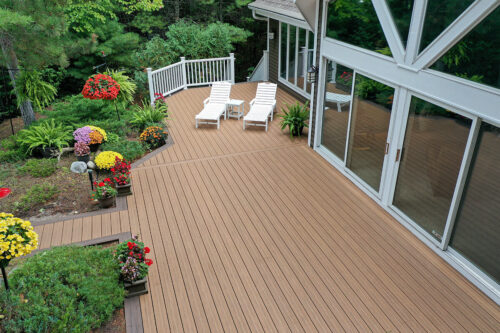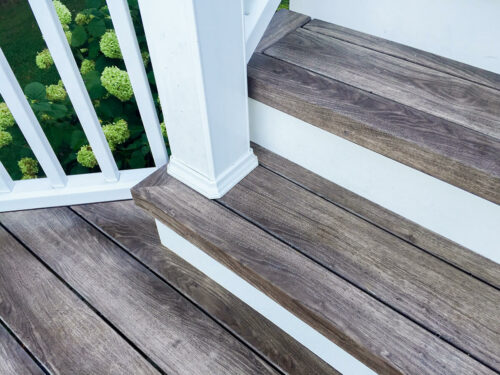Deck railings are essential for both safety and style in outdoor spaces. They not only provide necessary protection but also significantly contribute to the aesthetic appeal of your deck. From the natural charm of wood to the contemporary elegance of glass and cable, and the practicality of composite and vinyl, each type of railing enhances the overall look and feel of your outdoor area, reflecting personal taste and complementing your home’s architecture.
Composite and Vinyl Railings
Composite and vinyl railings are popular for their low maintenance qualities. They can be easily cleaned using water and a mild, non-abrasive detergent, and do not require painting, staining, or nails. Installation is straightforward, with many options offering hidden fasteners for a seamless design. These railings come in various attractive profiles to suit different personalities and lifestyles, with infill options such as glass or black round aluminum balusters.
Notably, all of our composite and vinyl railing systems are code compliant and undergo extensive testing to ensure safety and durability. In the long term, they are more cost-effective due to their longevity.
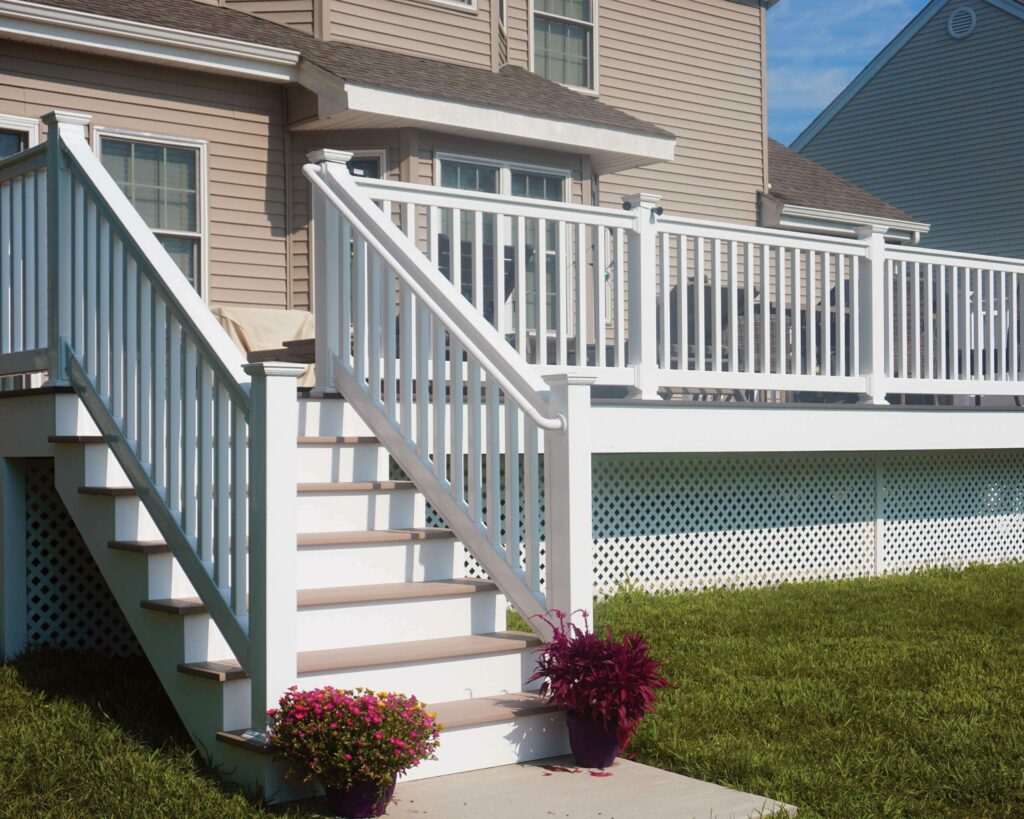
Wood Railings
Wood railings are a classic option with a traditional appeal. However, unlike the low-maintenance composite or vinyl railings, wood railings offer limited options. You can choose from two types of wood for the top and bottom rails — cedar or pressure-treated pine. The infill options are also limited, with choices such as square or beveled edge wood balusters. In contrast to other railing types, wood railings often have exposed fasteners like nails and screws.
Maintenance
Maintenance is a significant consideration with wood railings. They are not built to last forever and will exhibit natural imperfections like splinters and knots. Being more porous, wood is more susceptible to staining than composite or vinyl. For instance, pressure-treated wood may initially appear green and can fade to a grayish color over time. This fading necessitates the application of new paint, stain, or sealer every one to three years. Additionally, you will have to keep an eye out for mold, rot, fungus, and other forms of natural decomposition. These maintenance and upkeep requirements can add up in terms of cost over time.
Furthermore, wood railings are not subject to the same code testing as other railing types. This lack of required testing could raise safety concerns, especially as the railing ages.
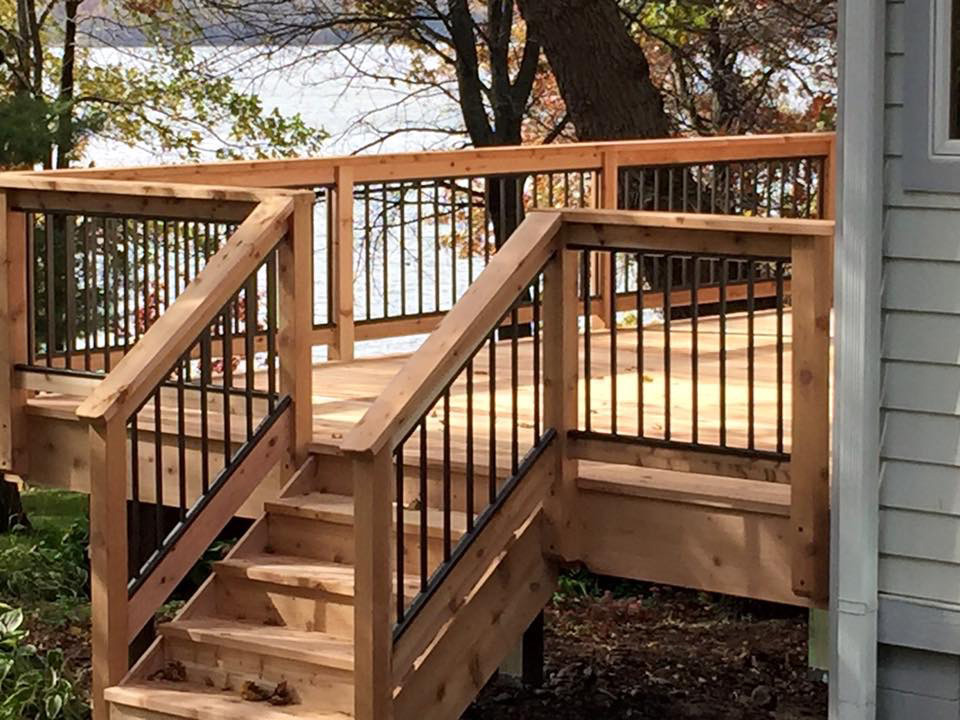
Comparison: Composite & Vinyl vs. Wood Railings
Composite & Vinyl | Wood | |
|---|---|---|
Maintenance | Low | High |
Design Options | Several composite and vinyl options | Limited to cedar or pressure-treated pine |
Stain/Paint | No painting or staining required | Painting and staining required every 1-3 years |
Infill Options | Several Options | Limited Options |
Fasteners | Hidden | Exposed |
Building Codes | Code tested for safety | Code testing not required |
Cost Over Time | Minor upkeep may keep costs to a minimum | Costs can add up over time |
Cable Railings
Cable railings are known for their ease of installation, requiring minimal tools, and offer customization throughout the process. This adaptability allows for seamless integration with other design elements of your home, such as coordinating the wood used in the railing’s framework with your doors, resulting in a polished and elegant appearance.
Enhancing Home Value
Cable railings not only complement a home’s aesthetics but also add value, especially when considering resale. They stand out with their creative and aesthetically appealing design, which is a significant advantage over traditional railings. Additionally, their design offers an unobstructed view, making them a preferred choice for many homeowners.
Low Maintenance
Constructed from materials highly resistant to corrosion, cable railings are durable and maintain their condition over time. Simple cleaning with a wet cloth and car wash soap is sufficient, eliminating the need for frequent repainting or replacement, unlike traditional wood railings. This low maintenance aspect is both convenient and cost-effective.
Unobtrusive View
The design of cable railings, featuring narrow, horizontal cables spaced evenly, ensures an unobtrusive view. This is particularly beneficial in settings like stairways and office balconies. In larger spaces, they help create separate areas without obstructing views, maintaining an open and airy feel.
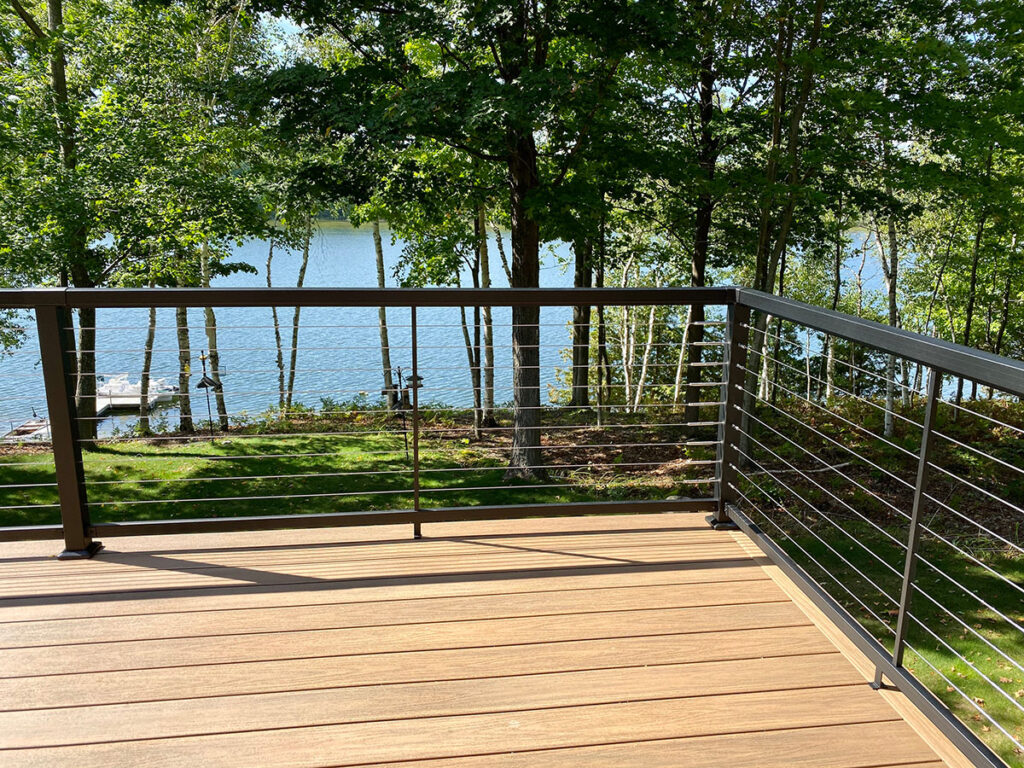
Conclusion
Modern cable railings are not only easy to install and maintain, but they also offer a unique visual appeal that enhances the overall look of a home. They align with contemporary home construction trends, providing an aesthetically pleasing, practical, and forward-thinking solution for home design.
Glass Railings
Style, Durability, and Versatility
Glass railings have emerged as a stylish and durable choice for various installations, including interior and exterior stairwells, decks, balconies, and pool enclosures. Their appeal lies in the limitless design possibilities they offer, limited only by one’s imagination.
Enhancing Interior Spaces
In interior settings, glass railings not only ensure safety but also contribute to the aesthetic appeal of a room. They play a unique role in absorbing, refracting, and transmitting natural light, brightening up spaces like homes or offices. This feature, coupled with their ease of maintenance, offers an open-concept look that is highly sought after in modern property designs, from office buildings to residential homes.
Safety and Maintenance
Glass railings are known for their exceptional safety, thanks to their tempered construction, which ensures robustness and the ability to withstand high winds and extreme weather conditions. This durability means they are not prone to decay, rot, or rust, and are impervious to damage from insects or pets. Maintenance is straightforward, with no need for staining, painting, or frequent replacements, making glass a long-lasting option, potentially enduring for decades.
Unobstructed Views and Aesthetic Appeal
A key advantage of glass railings is their ability to provide unobstructed views, aligning with the minimalist design trend. Unlike wood or other materials that can confine a space, glass railings maintain a clear line of sight, enhancing the perception of space. This quality is particularly beneficial for balconies and other outdoor areas where maintaining a connection with the surrounding landscape is desirable. Inside, they contribute to a sense of openness, making spaces feel larger and more inviting.
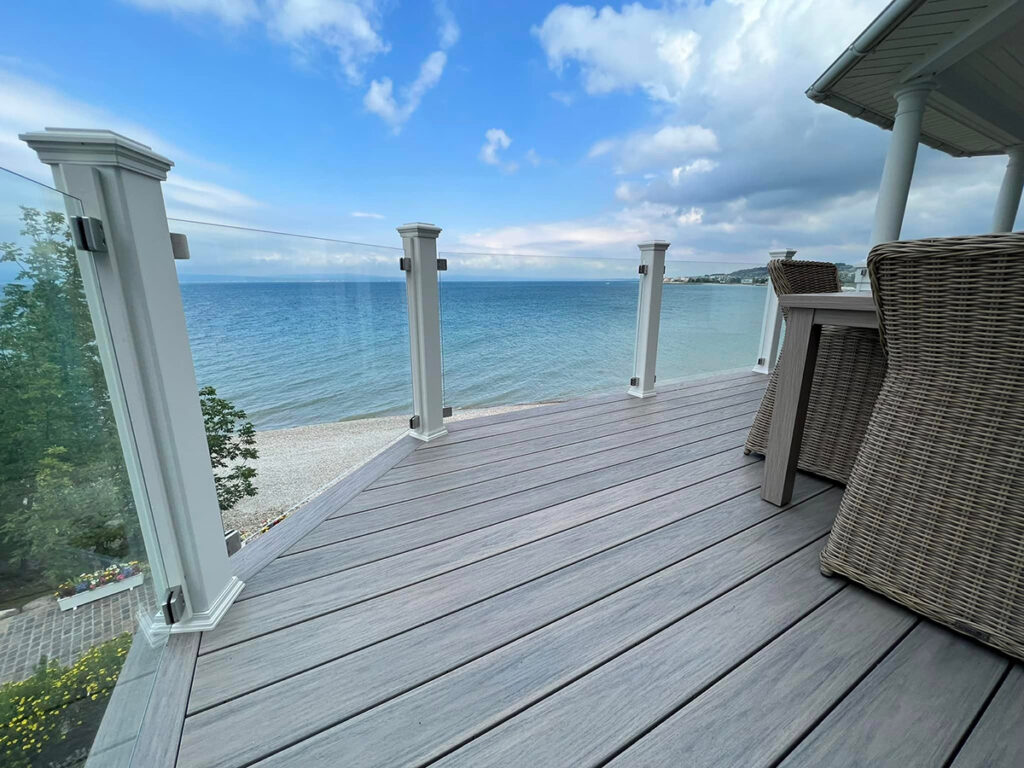
Versatility and Market Value
Glass railings are not only safe and visually appealing but also highly versatile, suitable for a range of applications including homes, office buildings, hotels, and multifamily properties. This adaptability, combined with their modern and sophisticated look, significantly boosts the market value of a property. Glass railings are often a preferred choice in high-traffic areas such as malls, stadiums, and airports, owing to their strength, durability, and safety.
Compliance and Installation Considerations
When installing glass railings, it’s important to adhere to local building requirements concerning mounting surfaces, railing heights, handrails, top rails, and glass thickness. This ensures that the installation is not only aesthetically pleasing but also compliant with safety standards, further enhancing its value as a safe option for both residential and commercial use.
Conclusion
In summary, the selection of railings is a significant aspect of architectural design, balancing aesthetics, functionality, and safety. Each material, from wood to glass, cable to composite, and vinyl, offers distinct benefits and contributes to the overall ambiance of a space. While wood adds a traditional charm, glass and cable options provide a modern touch with unobstructed views. Composite and vinyl railings offer durability and low maintenance. The choice of railing is not just a matter of safety; it’s also an opportunity to make a design statement and enhance the value and appeal of your property, making it a reflection of your personal taste and lifestyle.

